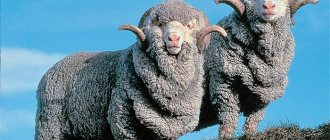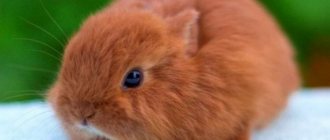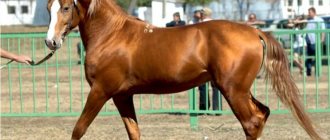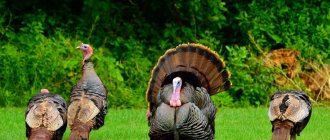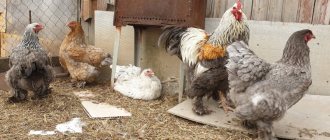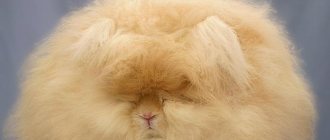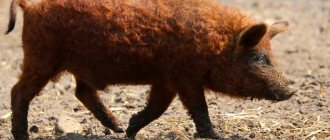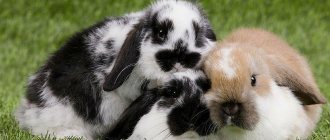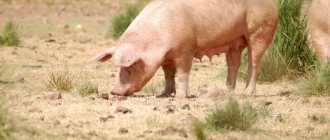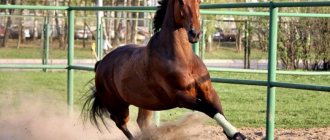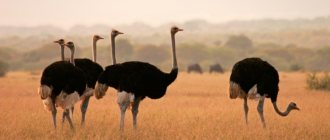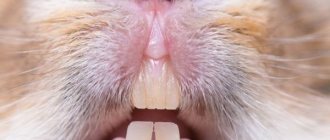- Wild animals
- >>
- Mammals
Merino is a breed of sheep, the largest number of which is concentrated in Australia. Outwardly, they are practically no different from other breeds of sheep. The main difference is the quality of wool, which in Merino wool consists of one and a half dozen fibers and is incredibly soft. The wool of this particular breed of sheep is most popular in various countries around the world.
Origin of the species and description
Photo: Merino
Sheep belong to chordates, classified into the class Mammals, the order Artiodactylae, the family Bovids, the genus Ram, and the species Merino. This breed of sheep is one of the most ancient of all existing ones. The history of its appearance goes back many centuries. The first descriptions of this breed come about 2 thousand years ago. The historical homeland of the ancient ancestors of modern representatives of this breed is the territory of North Africa and Asia Minor.
Video: Merino
During the period when the Arabs conquered new lands, sheep were transported to the territory of the Iberian Peninsula. It was here that the local population began to breed them in order to obtain high-quality wool. In the period from the 12th to the 16th centuries, Spain was the main region for the mass breeding of animals and their domestication. It was this country that was the main supplier of soft and very high-quality sheep wool.
Interesting fact: It was during the period from the 12th to the 16th centuries that sheep of this breed were bred exclusively in Spain. It was strictly forbidden to export them to other countries. Failure to comply with this requirement was the reason for imposing criminal penalties up to and including the death penalty.
In 1723, the Spanish authorities at the legislative level lifted the ban on the export of merino sheep outside their country. After this, the animals were brought to the territory of Sweden, and then to modern France. In 1788, these animals entered Australia. Each of the regions where these sheep were domesticated and bred in large quantities tried to improve the breed, improve the quality of the meat or the characteristics of the wool. As a result, a large number of subspecies appeared. Today, Merino is a breed that unites several dozen different subspecies of sheep. However, they all have common external features.
Content
Merinos are famous for the fact that they very easily adapt to different climatic conditions, which at one time allowed them to very easily spread from the hot semi-desert Australia and South Africa to the cold Sweden and Russia.
The Merino sheep breed has a wool characteristic that allows them to feel good in both bitter cold and sweltering heat.
Even in winter, these animals can be kept outdoors, using indoor penning only when absolutely necessary.
However, in the event of rain or heavy snowfall, sheep should be kept under cover, as wet wool is an ideal environment for parasites to appear.
Regular long walks (even on poor pastures) are generally more preferable for these sheep than staying in a pen. Only in the fresh air and in movement can you minimize the risk of fur parasites.
The sheep pen should be warm and dry, with good ventilation. To prevent wool from matting, sheep must be regularly bathed in special baths, and they must also be examined periodically by a veterinarian.
In winter, when free grazing is not possible, the basis of the sheep's diet should be hay and oats, which are their favorite delicacy.
You can also give a little barley, but you should always remember that without regular walking it provokes obesity in animals, as a result of which the productive characteristics of Merino sheep are reduced.
To diversify the diet, sheep can be given bran, bean flour; root vegetables, in particular (turnips, beets and carrots), are acceptable in small quantities.
Appearance and features
Photo: What merino looks like
The animal has a really quite unusual appearance. It bears little resemblance to the familiar domestic sheep. In appearance, the animals look like small, strong and short-legged animals. The entire body of the animal is covered with thick, long hair. It is arranged as if in waves, or even folds. Sometimes, because of the fur, it is even difficult to see the animal’s face. The body weight of one adult female is 40-50 kilograms, and one adult male is 90-110 kilograms. Individuals of this breed, like all others, exhibit pronounced sexual dimorphism. This manifests itself not only in weight and body size. Males have long, powerful horns that have a spiral shape. Coat color can be varied and depends on the subspecies.
What coat color can representatives of this type of sheep have:
- white;
- lactic;
- white with a yellow tint;
- beige;
- white with a dark gray tint;
- brownish tint.
Animal fur continues to grow throughout its life. The average length of wool that is recommended to be cut is 9-10 centimeters.
Depending on the subspecies in appearance, merino sheep are divided into three main categories:
- fine. They are not overly large in body size. There are practically no folds on their body;
- medium. They have a medium build and have 2-3 folds on the body;
- strong. They are distinguished by the most massive, large and stocky physique.
Productivity options
The productivity of individuals depends on the specific breed, subspecies and sex. The average performance of all Merinos is as follows:
- Fiens . Males weigh up to 70 kg and produce 9–20 kg fleece. Females weigh up to 40 kg and produce 4–10 kg of wool. Fleece quality - from 70 den.
- Mediums . Males weigh up to 85 kg and produce 9–20 kg fleece. Females weigh up to 45 kg and produce 4–10 kg of wool. The quality of the fleece is approximately 65 denier.
- Strongs . Males weigh up to 95 kg and produce 9–20 kg fleece. Females weigh up to 60 kg and produce 4–10 kg of wool. The quality of the fleece is approximately 45 den.
Where does merino live?
Photo: Australian Merino
Australia is considered to be the historical homeland of merino sheep. However, the animals were quickly domesticated and distributed almost throughout the globe. The largest farms engaged in sheep breeding on an industrial scale are located in the Volga region, the Urals, Siberia, and the central regions of the Russian Federation.
To raise sheep at home, care should be taken to create favorable conditions for the animals. They definitely need a barn. It must be dry and warm. You need to make sure there are no drafts. Due to the fact that animals are terrified of confined spaces, the ceiling height should be at least two meters. The area of the shed is determined at the rate of 1.5-2 square meters per individual. In the summer, the barn should not be stuffy, and in winter it should not be cold.
It is best if the barn has a vestibule. It should be easy to ventilate. The most comfortable temperature for keeping animals is from 6 to 13 degrees. Adjacent to the barn should be a paddock, the area of which will be approximately twice the area of the barn itself. Sippy cups and feeders must be available. Access to water is required at all times.
Feeding
The diet for representatives of the breed is not particularly refined. Mandatory ingredients are oats, bran, root vegetables, barley in small quantities. In summer, the herd feasts on fresh grass. In winter, the basis of nutrition is vegetables, mixed feed, and hay. Silage is not given to sheep, as coarse stems have a bad effect on the gastrointestinal tract. Various vitamin and nutritional supplements (chalk, salt, pea flour) are recommended. Don’t forget about water; individuals are provided with constant free access to drinking bowls.
What does Merino eat?
Photo: Merino sheep
Merinos are herbivores. In the warm season, the main source of nutrition is fresh green grass, which animals consume while grazing. Breeders of this species should make sure that they are able to spend a sufficient amount of time on pastures with lush green grass. After fattening on pastures, water should be provided to the animals to quench their thirst. On average, one adult requires 15-20 liters of water per day. The breeder of animals must take into account the fact that it is worth taking them out to pasture when the grass dries well. Otherwise, the animals may get wet and catch a cold. If the summer heat is sultry and the temperature rises, it is necessary to herd the animals into a stall so that at lunchtime they can shelter from the intense heat. After five hours you can send the animals out to graze again. With the onset of cold weather, it is worth taking care of a nutritious and varied diet.
What serves as food supply for merino:
- oats;
- hay;
- bran;
- compound feed;
- vegetables;
- pea flour;
- barley.
Merino breeders should pay special attention to hay preparation. It is best harvested in flat areas, and not in forests or swamps. Hay harvested in forests or swamps does not have sufficient nutrients. It will be practically useless for the sheep. To ensure that the animal does not get sick and has excellent wool quality, it is necessary to add vitamins and minerals to the diet in the form of special additives or ready-made feed mixtures. In summer, in addition to fresh herbs, it is recommended to add chalk, potatoes and rock salt to the diet. During the cold season, it is recommended to feed animals approximately 2-4 times a day. Merinos love to chew carrots and fresh, juicy apples.
Now you know what to feed your merino. Let's see what conditions are necessary for successful sheep breeding.
Wool value
Merino wool is highly valued due to its characteristics:
- Its fibers are several times thinner than those of other sheep breeds. Their thickness varies between 15-40 microns.
- Even unprocessed fleece is distinguished by its softness and tenderness.
- From one kilogram of merino wool it is possible to produce three times more fabric than from the same amount of sheared sheep of other breeds.
- Wool fibers from merino sheep have excellent thermal insulation properties. It is interesting that clothes made from the fleece of these animals are neither hot nor cold.
- Merino wool is hygroscopic, it quickly absorbs moisture.
- Fleece contains a substance with antibacterial properties, lanolin.
- Wool can be easily dyed any color.
Wool can be easily dyed any color
Attention! How thin the merino wool fibers are can be understood from an example - the density of hair per 1 mm of skin of these animals reaches 89, while other sheep have only 7-29 hairs on the same area of skin.
Features of character and lifestyle
Photo: Merino sheep in Russia
Merinos are herd animals that live in society. In their natural habitat, they also live as part of a group. The number of such groups in nature reaches from 15 to 30 individuals. It is in such conditions that animals feel protected. Zoologists have found that if one individual is separated from the entire group, it will receive incredible stress, which will manifest itself as a lack of appetite, decreased motor activity, etc.
Before becoming a pet breeder at home, it is worth studying their character traits. The main features of this type of animal are stubbornness, timidity and even some stupidity. Sheep of this breed, which are kept in artificial conditions, can gather in huge groups and simply follow each other, which creates great difficulties when being on pasture.
Zoologists say that sheep of this breed are extremely shy and have many phobias. They are very afraid of loud sounds, screams, knocks. They are characterized by a fear of the dark and limited space. When danger is sensed, a whole flock of sheep can run away at quite high speed. In a large group, there is most often a leader. This is a male specimen of the largest size. To avoid the unauthorized scattering of sheep in different directions, it is recommended to manage the most significant and dominant sheep. Merino sheep are considered quite hardy animals and are able to cover long distances.
Major diseases
Like all animals, merino sheep can get sick. But with proper care, proper feeding and proper water regime, many diseases can be avoided.
It is only inevitable that the wool of sheep is often attacked by various parasites, with which the owner of the flock will have to constantly fight so that the animal suffers less and the valuable fleece does not deteriorate.
Sheep hooves also require constant attention. They grow quickly, by 5-6 cm in a month, after which they begin to wrap themselves and dig into the skin of the animal. Dirt and stones get into the shoots, which can cause inflammation. Therefore, it is necessary to monitor and trim the hooves on time.
Drafts are dangerous for lambs. Babies can catch a cold and get pneumonia.
With proper care, many diseases can be avoided.
Social structure and reproduction
Photo: Merino baby
Merinos are very fertile animals. The period of sexual maturity in females occurs at the age of one year. Under natural conditions, the mating period occurs in the spring season. At home, the sheep breeder independently decides at what period to breed male and female individuals. The most favorable period is the end of winter and the first days of spring.
In this situation, newborn lambs are not exposed to the cold. Female Merinos do not always approve of the males that the breeder offers them. If at the first meeting a female individual does not pass the covering, animals of different sexes are brought together again after a few weeks. If the attempt is unsuccessful, it is useless to bring them together.
If it is possible to breed the sheep, pregnancy occurs. It lasts on average 21-22 weeks. During this period, a pregnant female needs special care and a balanced diet. One adult, sexually mature female can give birth to one to three small lambs at a time. 20 minutes after birth, newborn babies are already demanding mother's milk and sucking it with pleasure. They grow stronger and gain strength quite quickly. Lambs feed on mother's milk for the first 2-3 months.
After this, they begin to slowly eat plant foods that adults eat. By about a year they are ready to lead a separate, independent lifestyle and upon reaching puberty they are completely separated from their parents. Young individuals are ready to mate and give birth to offspring, just like the older generation. The average life expectancy is about 7 years. Some subspecies live on average 12-15 years.
When is it better to use woolen underwear and when is it better to use synthetic underwear?
If the activity is low and the person only sweats slightly and briefly, then an excellent way to maintain comfort and warmth is to use woolen underwear, if there is no allergy to it. Wool will also prolong the feeling of cleanliness and freshness.
If the physical activity is intense and prolonged or the operation is associated with serious mechanical stress (rupture, abrasion), then it is better to use more unpretentious synthetics. Especially if the thermal underwear is part of a three-layer system, where the effectiveness of each layer depends not only on its own characteristics, but also on the proper combination of all layers.
Natural enemies of merino
Photo: What merino looks like
When Merinos live in natural conditions, they have quite a lot of enemies. Giant saltwater crocodiles, which attack animals during watering periods, pose a great danger to animals. In addition to crocodiles, sheep are often hunted by the wild dogs Dingoes that live in Australia, as well as foxes and wild cats.
It is also worth noting that animals are quite sensitive and susceptible to certain diseases. For example, they can easily die from millet stress because they strayed from the herd. They stop eating, move little, and as a result die from exhaustion. Animals are very sensitive to dampness. In such conditions, they often suffer from pneumonia. Sheep begin to cough, practically stop eating, they have difficulty breathing and their body temperature rises. If the disease is not diagnosed promptly and treatment is not started, the animal will die. It is also necessary to care for the animals' hooves and periodically clean them to prevent the occurrence of hoof rot.
Every Merino breeder must understand that it is imperative to provide the animals with water treatments, during which they can clean the wool and get rid of parasites. Often, while grazing, animals can eat plants that are poisonous and inedible for them. In this case, the animal may die after just a few hours. Another reason for the death of sheep is improper care, unbalanced, irrational nutrition. These factors lead to vitamin deficiencies and diseases of the gastrointestinal tract.
Sheep shearing process. What you need for work, how to handle animals
Before the procedure, the animal should not be fed for 24 hours. Haircuts must be carried out from the age of one in the spring. Winter offspring are sheared at the end of summer.
For cutting, you should choose a dry place; the wool should also not be wet or damp to the touch. Usually two or three people cut their hair. One person holds the animal, and the other carefully trims the fleece. The procedure is carried out immediately, without delaying cutting other areas indefinitely.
After three weeks, the animal must be bathed. This can be done in a pond or on a site using a hose. The water pressure should not harm the animal.
What is warmer: down or padding polyester?
Merino wool products
Varieties of Merino breed
The breed has several varieties and differences, here are some of them:
- Soviet merino. The Soviet Merino sheep breed was bred during the Soviet Union, namely in 1925–1938, when breeders finally confirmed the breed’s welfare and its effectiveness. The ancestors of the Soviet merino are representatives of the coarse-wooled individuals of the Stavropol merino and the fine-wooled individuals of the Altai and Grozny. The breed was bred for meat and wool and is highly valued among breeders. Rams have a strong body, well and proportionally built. The average weight of rams is approximately 100–120 kg, and that of sheep – 50–60 kg. Coat color is beige, but perhaps gray, ash, cream. Rams have powerful horns and a longitudinal fold at the bottom of the neck. Animals are completely covered with hair, except for the nose, eyes and mouth. Due to its thick and dense fur, the animal looks like a barrel or a ball of wool. The length of the wool fiber is 8–10 cm. Up to 14–16 kg of wool can be sheared from an adult ram, and 7–10 kg from a sheep. Very prolific;
- Australian Merino. Fine-wool breed, the result of selection of English, German and Spanish breeds, there are also roots of Ramboulier and Vermont. The breed has three subspecies: Medium, Fine and Strong. The quality of wool varies among subspecies, but the breed is the leader in excellent wool performance. Fine representatives reach up to 70 kg in weight and have a fiber thickness of 70; Medum is a medium type of Australian merino weighing up to 85 kg with a fiber thickness of 66; Strong - the strongest representatives up to 95 kg, fiber thickness - 60. The total weight of wool from one animal is 10-20 kg. The breed's fertility is high;
- Askani Merino. The origin of the breed began in 1934, its homeland is Ukraine, the reserve is Askania-Nova. The animals are distinguished by particularly convoluted horns and strong body muscles. The weight of Merino rams usually reaches 120 kg, for females - 65 kg. The weight of wool fiber sheared from one ram per year is 16–20 kg, from a sheep – up to 7 kg. The wool of a fine-wool sheep is light beige, creamy or white, not very thick, fiber length 8–10 cm. Fertility is high up to 150%. With good fattening, it has high meat production rates. Young lamb meat is in particular demand; it is tender and has no specific taste, smell and minimal fat. After washing and cleaning, the wool yield is 45%.
